HOT RATS: OVERDUBS
Jazz played a bigger role in Zappa's next release "Hot rats". It's an album sometimes referred to as jazzrock, not so much because it combines rock 'n roll with jazz,
but because it uses electric as well as acoustic instruments.
It's a carefully balanced album with six almost entirely instrumental pieces:
"Willie the pimp" exists in three versions in Zappa's catalogue. On "Hot rats" it's the only track with lyrics, having Captain Beefheart singing them.
Below to the right you can see an outtake of his image on some sort of emblem from the CD leaflet.
"Son of Mr. Green Genes" first appeared on "Uncle Meat" as just "Mr. Green Genes", at that point a song with lyrics.
On "Hot rats" it's all instrumental. The themes and the soloing
follow a chord progression all through:
The "Gumbo variations" is the largest piece on the album, 16 minutes in total, including extensive soloing. Its
central theme is a two-bar riff, that gets varied upon a couple of times
(see bars 9-10 of the first example for its introduction).
"It must be a camel" can be subdivided in a number of sections, where I'm here following the set-up from the Hot rats guitar book.
"Bognos Regis" is a title that stayed unreleased by Zappa himself, though it has been known for long via the bootleg circuit.
It's included in "The Hot rats sessions" in two shapes, the longer "unedited master" version from 1969, and the shorter "Record Plant mix"
from 1970. The example below is transcribed from the first one.
The "Peaches jam" was recorded on 7-28-69 when the basic tracks for "Peaches en regalia" got recorded. The two parts included in the "Hot rats
sessions", however, contain no references whatsoever to the thematic material from "Peaches en regalia". The first part is the session musicians jamming
without Zappa participating. If I'm reading it correctly the musicians during the jam were:
During the Hot rats sessions members of the Mothers of invention were also present. Recordings involving the Mothers were used for the "Burnt weeny sandwich"
album. "Another waltz" is another jam session, lasting 27 minutes. The musicians are:
"Lil' Clanton shuffle" is blues beginning in C Mixolydian. The example below shows the last four bars from the blues cycle, followed by the first
two bars with the band improvising. As is common in blues, chords can deviate from the principal tonality.
As soon as the soloing starts, this piece continues in C Dorian. Using Dorian and Mixolydian next to each other is common is Zappa's music.
The triplets in case of a 4/4 notation, or the 12/8 meter, must be the reason for calling it a shuffle.
"Twenty small cigars" from "Chunga's revenge" comes into this album directly from the 1969 "Hot rats" sessions. Other than "Sharleena"
it wasn't re-recorded with the new band formed in the summer of 1970.
- "Peaches en regalia" and "Son of Mr. Green genes". Two relatively relaxed pieces.
- "Willie the pimp" and "The Gumbo variations". Tracks based upon a riff followed by extensive soloing.
- "Little umbrellas" and "It must be a camel". Complicated music with various interwoven melodic lines. Especially "It must be a camel" is harmonically versatile.
The album shows the synergy of the cooperation between Zappa and Ian Underwood. Ian Underwood made his first appearance on "We're only in it for the money" and pleased
Zappa by being able to play all kinds of complicated music, taking away some limitations Zappa had had to deal with earlier. Underwood got stimulated
to reach the level he's demonstrating in his saxophone soloing in "The Gumbo variations". The majority of the parts of "Little umbrellas" and
"It must be a camel" are played by Underwood, where Zappa is applying a lot of overdubbing. "Hot rats" got released in the US at the end of 1969 where it initially
did little. At the start of 1970 it got released in Europe as well with an opposite response. It reached the album top 10 in the UK.HOT RATS
1. Peaches en regalia (1969)
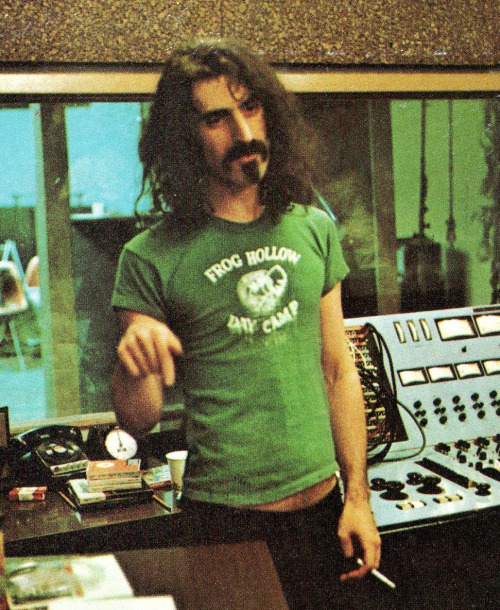 "Hot rats" has two songs that have a scent of the classical sonata form for a single movement, namely "Peaches en
regalia" and "Little umbrellas" (tracks 1 and 4). They both have repeated themes at the opening, which return
at the end. In between is a block that has a more free variation set up, with new themes
related in character to the opening themes (more on this subject in
the "Orchestral favorites" section). The main scale of "Peaches en regalia" is B Dorian, but it's one of many examples with a multitude of modal scales
passing by. For themes I and II Zappa is using 4/4 with
standard rhythms. He continues in 4/4 for the third theme, but here the rhythm gets more complicated: an irregular form of a string
of 16th notes with pauses in between them, followed by a syncopic bar. The set-up of the complete song can be followed
in the Hot rats guitar book (see below for samples), using the block indications from their score:
"Hot rats" has two songs that have a scent of the classical sonata form for a single movement, namely "Peaches en
regalia" and "Little umbrellas" (tracks 1 and 4). They both have repeated themes at the opening, which return
at the end. In between is a block that has a more free variation set up, with new themes
related in character to the opening themes (more on this subject in
the "Orchestral favorites" section). The main scale of "Peaches en regalia" is B Dorian, but it's one of many examples with a multitude of modal scales
passing by. For themes I and II Zappa is using 4/4 with
standard rhythms. He continues in 4/4 for the third theme, but here the rhythm gets more complicated: an irregular form of a string
of 16th notes with pauses in between them, followed by a syncopic bar. The set-up of the complete song can be followed
in the Hot rats guitar book (see below for samples), using the block indications from their score:
Themes
0:00 Block A (bars 1-2 in the example below). Theme I in B Dorian.
0:21 Block B (bars 5-8 in the example below). Theme II in B minor. See also the Tinsel Town rebellion section
for more details about this section, where it re-appears as "Peaches III".
Peaches en regalia, blocks A, B and the beginning of C (midi file).
Peaches en regalia, blocks A, B and the beginning of C (transcription).
0:41 Block C (bar 13 etc.). Third theme. This theme begins with a two-bar motif in B Dorian. Hereafter this motif gets transposed twice, as D Dorian
and F Dorian. Next you've got another motif in Db Mixolydian, followed by yet another motif in B Mixolydian.
Middle block
1:05 Blocks D-E. The song continues in an improvised manner. A still written melody is played over a I-II alternation in E, followed by a
little guitar solo over a I-VII alternation in A Lydian. The second example below begins with the last two bars from section E.
1:34 Block F. A melody over a chord progression, using two different major-type scales per bar (bars 7-9 from the example below) and ending in G Mixolydian (bars 10-11).
1:46 Block G. A chord progression in F, being I-V-IV. It gets played four times during bars 12 through 19.
2:05 Block H. Variation upon the material from block F, beginning with the first bar transposed down a minor third (bars 20-24).
Peaches en regalia, blocks D (end) and E through H (midi file).
Peaches en regalia, blocks D (end) and E through H (transcription).
This second example can be heard between 1:19 and 2:16. The exact same section from "Peaches en regalia (1971)",
a live performance, is included in the Fillmore East section from this study where I'm pointing at the many small detail differences between these two versions.
Return of the themes
2:16 Block I goes like block A.
2:35 Block J goes like block B.
3:37 End.
"Peaches en regalia" has become a Zappa classic in another sense as well. It's
generally appreciated and Zappa recorded it three times. In 1971 Flo and Eddie did some
of the parts vocally for the mentioned live version on "Fillmore East". Ten years later
another live version appeared on "Tinsel town rebellion", called "Peaches III".
To quote Zappa from the album liner notes: "It is called Peaches III because this is
the third time I have released Peaches (En Regalia) on record ... first on the Hot Rats
album, then on Live At The Fillmore ... but this version is so bizarre, I figure you
wouldn't mind hearing it again". The bizarreness doesn't so much relate to the composed part as on
"Hot rats", but more to the epilogue with the "Let's hear it for another great Italian"
section followed by the concert ending lines. See the Tinsel town rebellion section for an outtake from this version.
"Peaches III" has some extra counterpoint figures at the return of theme B,
that also appear as pizzicato notes in the Ensemble Modern version on their "Greggery Peccary
and other persuasions" CD from 2003 (see the left menu for more about this CD).
Image above to the right: Zappa during the recording of Hot rats (sample from the album cover).

"Peaches en regalia" is also available in an arrangement for orchestra at Schott Music.
Above the Talichova Komorní Filharmonie performing this piece, as televised in 2012.
2. Willie the Pimp (1969)
Hot rats
- 0:00 Main theme, introduced instrumentally. Next Beefheart starts with the lyrics ("I'm a little pimp with my hair gassed back ...").
- 1:07 Shorter sung side theme ("Hot meat, hot rats, hot cash, hot ritz ..."). The bass starts varying the main theme, gradually moving towards a free improvisation,
though maintaining an A pedal type of accompaniment (the song is in A Dorian throughout). Zappa starts soloing.
- 2:13 The piece continues instrumentally.
- 8:48 The main theme returns.
- 9:16 End.
Fillmore East, June 1971
- 0:00 2nd appearance of the "Latex solar beef" theme. As I understand it there are other releases with this section being part of
"Latex solar beef" itself. My CD has Rykodisc RCD 10512 as release number.
- 1:01 Main theme from "Willie the Pimp" (1971), played instrumentally as in the example included in this study (Fillmore East section). While the "Hot rats"
rendition is melodic, this version contains a chord progression as well. Because the side theme from above is textual rather than melodic, it doesn't return
in this version without lyrics.
- 1:31 The main theme is used as the starting point for a guitar solo, called part one of it. Part two was the opening track of side two of the original
album edition, but got skipped on the CD re-release.
- 4:03 End.
YCDTOSA vol. IV
- 0:00 Main theme.
- 0:21 Additional theme ("she can't be (beat) ...").
- 0:31 The main theme and additional theme get repeated.
- 0:51 Main theme some more, followed by the side theme from above, this time with a fixed accompaniment figure.
- 1:05 Guitar solo over an inversion of this figure.
- 1:57 The solo ends with the opening melody from "Montana", into which song this track segues.
- 2:05 End.
Willie the Pimp solo, 2:34-2:52 (midi file).
Willie the Pimp solo, 2:34-2:52 (transcription).
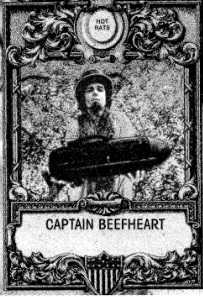 When you compare the solo example from above - or pages 15-29 from the Hot rats guitar book - with the Frank Zappa guitar book from 1982, you can see that
the solo from "Willie the pimp" is untypical of Zappa. This goes for more solos from the sixties. There are relatively few of them on album and
Zappa hadn't yet developed his personal style as explicitly as at the end of the seventies. In this case he's about always following the downbeat and playing on beat
too. The 16th note is the central time unit and there are few accelerations and irregular rhythmic groupings (apart from triplets). There are many bars with him using chords
(as in the example from above), something he would call a "rhythm guitar solo". See the "Chunga's revenge" solo from 1975 from the Joe's series
section from this study for a clear example of such a rhythm guitar solo. Technically, and as it comes to variation, the existence of these solos is of interest.
I'm also addressing to the difference between earlier and later solos in the Fillmore East 1970 section of this study as it comes to the interaction between
players. In this case the contribution
of Max Bennett on bass is of importance. At some points it sounds as if Zappa and Bennett are playing a duet. On the other hand the keyboard
part stays in the background, being a sustained pianissimo Am chord most of the time.
When you compare the solo example from above - or pages 15-29 from the Hot rats guitar book - with the Frank Zappa guitar book from 1982, you can see that
the solo from "Willie the pimp" is untypical of Zappa. This goes for more solos from the sixties. There are relatively few of them on album and
Zappa hadn't yet developed his personal style as explicitly as at the end of the seventies. In this case he's about always following the downbeat and playing on beat
too. The 16th note is the central time unit and there are few accelerations and irregular rhythmic groupings (apart from triplets). There are many bars with him using chords
(as in the example from above), something he would call a "rhythm guitar solo". See the "Chunga's revenge" solo from 1975 from the Joe's series
section from this study for a clear example of such a rhythm guitar solo. Technically, and as it comes to variation, the existence of these solos is of interest.
I'm also addressing to the difference between earlier and later solos in the Fillmore East 1970 section of this study as it comes to the interaction between
players. In this case the contribution
of Max Bennett on bass is of importance. At some points it sounds as if Zappa and Bennett are playing a duet. On the other hand the keyboard
part stays in the background, being a sustained pianissimo Am chord most of the time.
3. Son of Mr. Green Genes
- I-IV alternation in D Dorian.
- I-VI alternation in C, followed by IV-V-VI. One might also interpret this as D Dorian continuing instead of C becoming the tonic,
then it's a VII-V alternation in D Dorian.
- Ending in Bb Mixolydian or Bb Dorian (both D natural and Db are getting used). At this point the orginal "Mr. Green Genes" continues with
a final chord progression for what I'm calling theme C, skipped during "Son of Mr. Green Genes". See the The best band you never heard in your life
section of this study for the details, as performed during a 1988 live version of "Mr. Green Genes".
Ultimately, at the end of "Son of Mr. Green Genes", it's closing in D Mixolydian.

Guitar transcriptions from most parts from "Hot rats" have been published as the Hot rats guitar book, Hal Leonard publ. comp., Milwaukee, 2001.
The transcriptions are by Andy Aledort. Above are the opening bars of the soloing over the I-IV alternation in D Dorian.
Son of Mr. Green Genes, 6:29-7:03 (midi file).
Son of Mr. Green Genes, 6:29-7:03 (transcription).
The example from above contains the two final bars from section J from the Hot rats guitar book and the first 12 bars from section K. During section K
some variations upon the scheme can be noted. During bars 3-4 the Dm and G chords are emphasized. Other than during the other sections, the G chord gets
maintained for three bars instead of one. During bars 11-12 it looks like the bass player, Max Bennet, might want to modulate to F, starting with F and using a Bb.
But this is an incidental effect caused by the improvisation element in the bass part. Bars 13-14 continue with C and Am as normal. It's difficult to tell which
parts were written out in advance, which parts where agreed upon during the recording of the overdubs and which parts were freely improvised. Section K seems to be
a mix of all three.
In his response to me you can read that Brett Clement doesn't agree with my inclusion of Mixolydian:
- "Not Bb; Zappa does many different things over the Bb chord; overall, it is consistent with blues minor pentatonic playing."
- "The D major chord at the ending is just a "Picardy third" in D minor."
Following the transcription by Andy Aledort you're having the following over the Bb chord/Bb pedal:
- Page 31: Bb-C-D-Eb-F-Ab
- Page 32: Bb-D-E-F-G-A
- Page 34: Bb-D-F-G-A
- Page 35: Bb-Db-Eb-F-A/Ab
- Page 36: Bb-Db-Eb-F-Ab
- Page 37: Bb-C-D-E/Eb-F-G
- Page 38: Bb-C-D-Eb-F-G-Ab
- Page 39: Bb-C-D-Eb-F-G-Ab
- Page 40: Bb-Db-F-A/Ab
- Page 41: Bb-Db-E/Eb-F-Ab
- Page 42: Bb-Db-Eb-F-Ab
Bb Mixolydian = Bb-C-D-Eb-F-G-Ab.
Bb Dorian = Bb-C-Db-Eb-F-G-Ab.
Bb minor Pentatonic = Bb-Db-Eb-F-Ab.
None of these three scales overall fits, but standard Mixolydian is happening on pages 38 and 39. Specifically on page 38
you can see a playing up and down the Mixolydian scale. The frequent switch to Db adds a Dorian element to it. Pentatonic happens too
on pages 36 and 42. The Picardy third stands for letting a composition in minor/Dorian end with a major triad upon the tonic instead of a minor triad.
When you do call it that way, it doesn't mean it becomes wrong to say the last bar is in D Mixolydian. It's not just the D chord, but playing through the complete
Mixolydian scale (though also including an F chord with an F natural).

The coda from Son of Mr. Green Genes (Hot rats guitar book, page 42). The bass pedal note in the final bar is D.
4. Little umbrellas
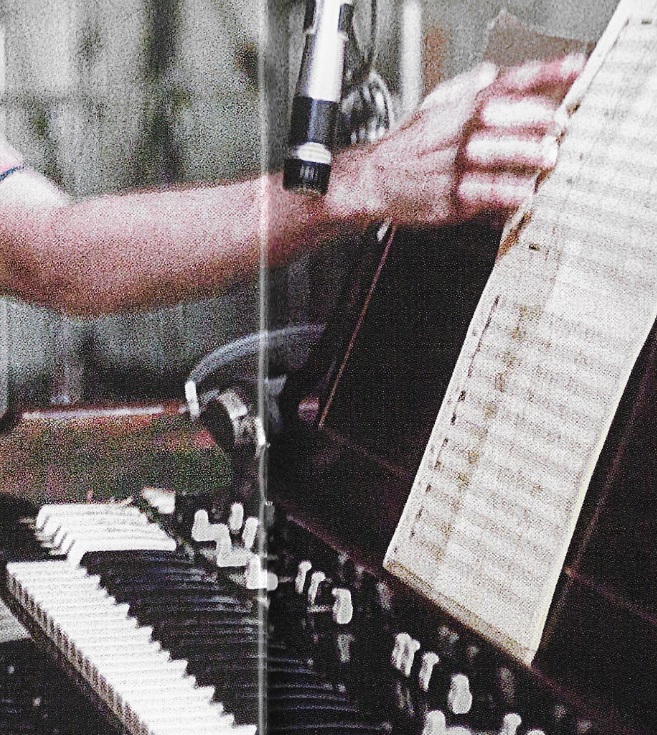 In the case of "Little umbrellas", the sonata-like construction goes as:
In the case of "Little umbrellas", the sonata-like construction goes as:
- 0:00 Theme A, played twice.
- 1:05 Theme B.
- 1:12 Middle block.
- 2:17 Theme B returns.
- 2:31 Theme A returns.
Ludwig's study includes the main melody of "Little umbrellas", whereas about 2/3rd of "Hot rats" got transcribed in 2001
by Andy Aledort (the "It must be a camel" section from below was published just before this release). Andy also includes the main melody
of "Little umbrellas", but skipped the middle block. Apart from Zappa's own solos he doesn't include the overdubbed and
improvised parts, other than by chord indications. For a cover band that could be enough.
This section is about overdubbing and the midi files are intended to approach the exact album versions, so
more details are included. To the right: outtake of a photo by Bill Gubbins with Zappa pointing at one of his scores while
Ian Underwood is playing organ (The Hot rats sessions CD).
Little umbrellas, 0:36 till 1:16 (midi file).
Little umbrellas, 0:36 till 1:16 (transcription).
This first example below contains the repetition of theme A plus the larger
part of theme B. The first two bars are accompanied by a Dsus2 and Fm7 chord progression.
Both Wolfgang Ludwig and Andy Aledort are notating "Little umbrellas" in D minor. If you want to relate this song to
any key, then D minor or Dorian is indeed the only option. The D-F movement dominates. You've got a lot of altered notes that way
though. In the 4th pdf edition of this study I'm suggesting that the scale over the Dsus2 chord could be interpreted as D major,
but after relisting I would like to withdraw that. The D chord I first notated should be Dsus2 and the bass line plays a C right from
the beginning. So, without an F#, there's insufficient ground for doing so, and the C# in the melody should be interpreted as a chromatic passing note.
Bars 5-6 have varying pedal notes and incomplete scales, so the scales can't be identified positively (it's also hard to hear each individual note here).
The piano plays the extended
chords in improvised arpeggio forms (staves 2-3). Bar 7-8 don't follow a specific key. Bars 9-10 are stable again, here in A minor.
The main theme is played three times, each time sounding different. The basic
notes of the melody are identical each time, but the overdubs create a different harmonic climate in every repetition
of the theme. In bar 11 of theme B the overdubbed line is playing a counterpoint line. It's getting chromatic here with only fragments of scales being used.
The middle block of "Little umbrellas"
is a strong example of overdubbing, because Ian Underwood
is playing three keyboard parts with individual lines. The bass is setting a pedal note per bar. The result is
dense harmonies and counterpoint, difficult to transcribe. Next is the section from this middle block between 1:20 and 1:35.
Little umbrellas, 1:20 till 1:35 (midi file).
Little umbrellas, 1:20 till 1:35 (transcription).
This middle block is built over an eight bar progression with a chord per bar, repeated twice, as indicated in Andy's Guitar book. Included
above are the first four of these bars with the progression E-F#-G-A. Over these chords two or three melodies are played,
moving freely through the scales, that change per bar. At this point it's E, F# and G Mixolydian, and possibly also A Mixolydian.
This last bar is ambiguous. In 2019 the ZFT released "The Hot rats sessions", including the basic tracks recording of this title, at that time
called "Natasha". On the basic tracks the chord is brightly A.
In the example above, however, bar 4 sounds more as A minor/Phrygian (the A chord is mixed to the background, with the C# getting
inaudible, while the F is natural and the B turns up as natural and flat).
Thus the whole becomes to sound as a series of harmonic fields, blending all or most notes of a scale
in each bar.
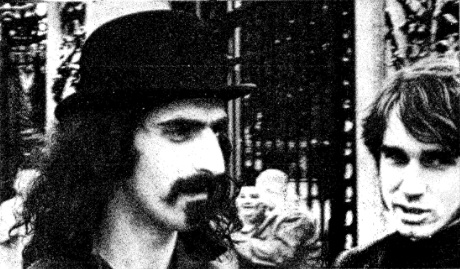
Ian Underwood with Zappa in London (CD leaflet).
Little umbrellas (Cucamonga), 1:26-1:50 (midi file).
Little umbrellas (Cucamonga), 1:26-1:50 (transcription).
In 2019 the ZFT released the "Hot rats sessions", showing that, as a composition, "Little umbrellas" goes back to the Cucamonga period (1961-1964). An acetate
recording exists. It can't be exactly dated, nor ar the musicians known, other than Zappa on guitar. The other parts concern a saxophone, playing the lead melody,
and drums. The lead melody at the opening is played basically the same as on "Hot rats". Here I've included its return at the end, where it is varying a little
upon the opening. On this occasion the harmonic basis for the opening bars is a D-Fm alternation, not identical but comparable with how it's performed in 1969.
On this occasion there isn't a bass guitar pedal note confirming a tonic, it's rather fluctuating as it comes to the use of keys.
5. The Gumbo variations
The Gumbo variations, 0:13 till 0:46 (midi file).
The Gumbo variations, 0:13 till 0:46 (transcription).
Motifs taken from this theme turn up during the sax solo
as well as forming a returning element in the guitar accompaniment.
It gets preceded by one of the many bass riffs that you can find in this song. During bars 9-14 this bass riff keeps
playing against the central theme. The opening contains the principal chord progression that accompanies the lead melody and the
soloing: G7-C-G, a standard progression with the dominant 7th chord resolving. As you can read in the "Real FZ book", Zappa
didn't particularly like the idea of resolving chords, but he didn't oppose it altogether neither. You can see the same
progression at the beginning of "I was a teenage maltshop" and as part of the "Cheap thrills"/"No, no, no" accompanying chords.
For examples of the use of the dominant 7th both resolving and non-resolving , see the Frank Zappa songbook vol. I, pages 22-23 and 70.
At the other side of the spectrum you have for instance the chord alternation from "Black napkins", C#m7-Dmaj7. Here the two
7th chords not only don't resolve, but change scales as well.
Interesting to see is the simultaneous use of two scales. The
"Gumbo variations" start in G Mixolydian. This basis continues when
the central theme enters the picture, but both this theme and most of the soloing are using a Bb instead of a B. So
Zappa is here blending G Mixolydian and G Dorian.
The Gumbo variations, 9:40 till 10:05 (midi file).
The Gumbo variations, 9:40 till 10:05 (transcription).
This second example is a section from this song with the band modulating.
It's the part with Don "Sugarcane" Harris playing an electric violin solo. In bar 4 the guitar plays a progression using Bb,
setting the key more clearly to G Dorian. Max Bennett on bass comes up with another syncopic riff. He immediately modulates
to D minor from bar 5 onwards by changing the pedal note. In bar 12 we're back at G Dorian with simply G as a bass pedal note.
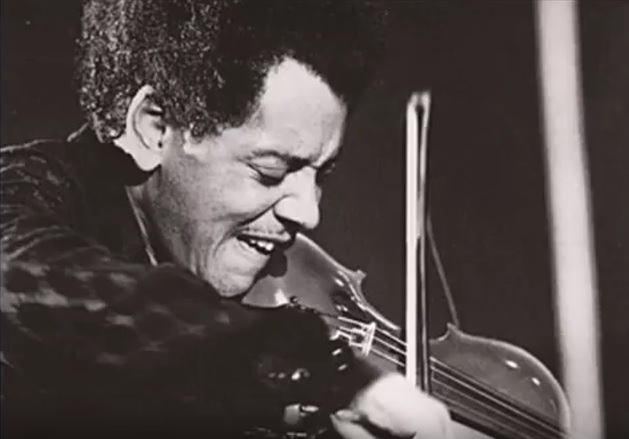
Don "Sugarcane" Harris.
6. It must be a camel
Section A
This title begins with an intro for piano, bass and drums. In it extended chords and modulations are standing central.
The meter is stable in 3/4 with the bass playing the root of the chords.
It must be a camel, 0:00-0:31 (midi file).
It must be a camel, 0:00-0:31 (transcription).
Bar 1: The Fmaj9-add6 chord in F. The main theme and final section are using the same chord scheme as section A.
Minor differences in its execution are causing some ambiguity about how bars 1-3 should best be identified.
Lydian and major are closely related scales, in case of F being the tonic differing by a Bb versus a B natural. During the intro this B/Bb appears only once in bar 1 as a Bb
by the bass. A second time at the end of bar 2 as a B natural, but passing between C and Bb, so this has no meaning for identifying the scale.
During the main theme bars 1-2 are in F Lydian, using a B natural.
Bar 2: Csus2.
Bar 3: Bbsus2. Below, in the context of the final section, I'm calling this a modulation to Bb Lydian.
Here it can also be seen as step IV of F.
Bar 4: Modulation to A minor or Dorian, the chord being Am7-add4.
During bars 4-7 the F/F#, that distinguishes minor and Dorian, isn't used. As said, the chord scheme from section A returns during the main theme,
where an F# does turn up. So, with hindsight, Dorian suits better.
Bar 5: Gsus2-add4.
Bar 6: D9sus4 (no 3rd).
Bar 7: Csus2.
Bar 8: Modulation to B minor with B-C#-E-F#-A as chord. This chord is thus uncommon that it can't be readily coded. Andy Aledort calls it B7sus4.
In that case add2 should be added, a C# is certainly present.
Bar 9: Asus4-add7. Asus2 in the Guitar book is a writing error, both Andy and me are hearing a D.
Bar 10: Modulation to Eb Lydian with Ebsus2.
Bar 11: Dm7.
Bar 12: Modulation to Ab Lydian with Abmaj9. The next chord is Gsus4, so Ab Lydian suits better than Ab.
Section B
The main theme, partly returning at the end. See below at the final section.
Section C
The overdubbing reaches a climax by creating a
modern orchestral atmosphere in the intriguing section between 1:45 and 2:25. I've transcribed 11 bars below. Because
of its harmonic density the transcription can only be an approximation of what's going on. These bars are also an example of Zappa's search for rhythmic diversity.
Within a 3/4 framework several varieties are being used. Several bars have syncopic figures, some bars have a subdivision into two, while bar 8 is straight.
The ZFT "The Hot rats sessions" box contains the recordings of the basic tracks from "Hot rats". In case of "It must be a camel" this concerns bass, drums and
the underlying chords as arpeggios. It gave me the opportunity to listen to their details much more closely and enticed me to renew the example below once more
(it has been in this study since 2001).
It must be a camel, 1:44-2:11 (midi file).
It must be a camel, 1:44-2:11 (transcription).
Bar 1: This section starts in A Lydian and immediately falls into an incomplete 13th chord. The remaining notes appear in the chords
following upon the arpeggio chord.
Bar 2: In the second bar the key changes to G# minor. The changing of scales and the use of enlarged chords continue except for bars 9 and 10, which are
normal and form a short break. In both bar 1 and 2 the individual parts are playing via counterpoint and harmonic complementary lines.
Bar 3: G minor type (G-Ab-Bb-Cb-Db-Eb-F). The descant moves on with parallel fourths on beats 2-3.
Bar 4: Mostly Db Lydian, though the initial arpeggio chord is using an E. On the left and right channel you can hear different strings of fast notes played simultaneously.
One would need to listen to the individual tracks to get this precise. The pedal note in this bar is Db instead of F, as I had notated it first. The basic
tracks recording brings this to the open more clearly. One should also notice the differences in how the arpeggio chords are played, sometimes starting
on beat, sometimes ending on beat. It does affect the sound and playing them as plain chords would turn the whole sound as plump masses.
Bar 5: Bb major/Lydian. At this point the piano starts lower than the bass.
The last string from bar 4 leads to another extended chord. Two parallel fourths lead downwards to bar 6.
Bar 6: Gb major/Lydian. Two extended chords alternate in a syncopic manner.
Bar 7: A Lydian. The opening chord returns a 16th note behind the meter line. Two other chords lead to bar 8, again in a syncopic manner.
Bar 8: Bb major. The descant sustains a chord, while the piano bass part plays six parallel fourths as a series of plain eight notes.
At this point both the bass and keyboard part from the basic tracks are mixed to the background. Also in some other bars the bass is less present,
the reason why there weren't pedal notes at the end of my earlier transcription.
Bar 9-10: C Lydian. The 3/4 meter gets subdivided into two. Here the descant is briefly using single notes instead of chords.
Bar 11: B Lydian. Yet again an extended chord, here with two trills on top of it.
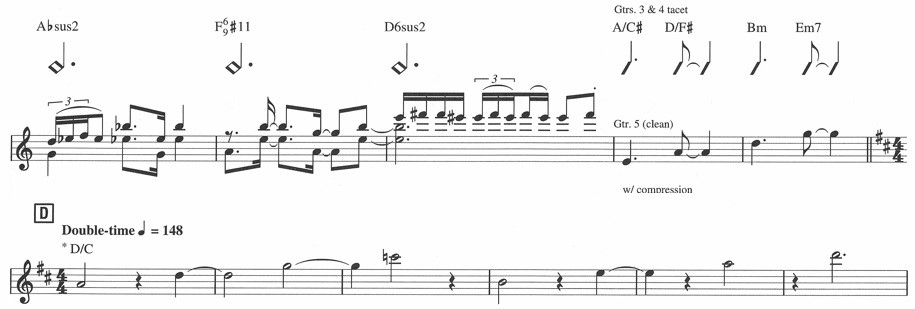
Final bars from section C and opening bars from section D (source: Hot Rats guitar book). The rhythm of the two final bars of section C is continued during the opening of section D,
though within another meter.
Section D
Section with Zappa soloing on guitar. The basic tracks recording shows that at least the number of bars was set in advance, maybe more.
The meter has become 4/4, in double time compared to the two examples from above.
It must be a camel, 2:50-3:10 (midi file).
It must be a camel, 2:50-3:10 (transcription).
Contrary to the examples from above, the use of scales is stable during this section:
- 16 bars starting as if in C Lydian, though the bass does not really confirm a key note.
My example begins with the final bar of this block. On the academia.edu site you can find an article
by Brett Clement, called "Why Hot Rats matters". About this block he notes: "As shown in my final example, the beginning of Zappa's guitar solo
in "It must be a camel" (figure 9) [KS: the opening of section D as shown above], the melodic use of ambiguous stacked perfect fourths (A-D-G-C and B-E-A-D) over a D/C chord
creates some confusion about whether the scale is C Lydian, matching the note in the bass, or D Mixolydian, matching the D triad.
As the solo continues, D takes over as the more emphasized pitch/chord."
- 16 bars in B minor. The first five bars are pentatonic. Next the C# joins in and finally a G in bar 11.
Sections E and F
Section for the horns and for horns and guitar alternating. In the Hot rats guitar book the improvised keyboard part from the basic tracks
isn't written out, so some bars remain empty.
Finale
The final section begins with repeating bars 1-6 from the main theme (section B), though not identically. Next the coda begins,
of which the first five bars are included in the example below.
It must be a camel, 4:21-4:49 (midi file).
It must be a camel, 4:21-4:49 (transcription).
As also said above, the main theme is using the same keys and basic chords as section A, both lasting 18 bars. Between sections A and B a little percussion moment
got added in after bar 18. The finale is yet again using this 18-bars scheme. Bars 1-6 of course by repeating the main theme. The coda
continues with the remaining 12 bars of the scheme.
Bars 1-2: The main theme starts in F Lydian. The piano chords from the basic track during this example are sometimes lightly audible, at other
points mixed to the background to becoming inaudible. I haven't included such dynamics in my example.
Bar 3: Modulation to Bb Lydian.
Bar 4-6: Modulation to A Dorian.
Bar 7: First bar of the coda, still in A Dorian.
Bars 8-9: Modulation to B minor.
Bar 10: Modulation to Eb Lydian.
Bar 11: The basic tracks recording suggests Dm7 as above. The piano chords, however, are mixed to the background, and the two semiquaver trills
are adding a chromatic element. Because the Dm7 chord is hardly audible, it causes no serious dissonances.
THE HOT RATS SESSIONS
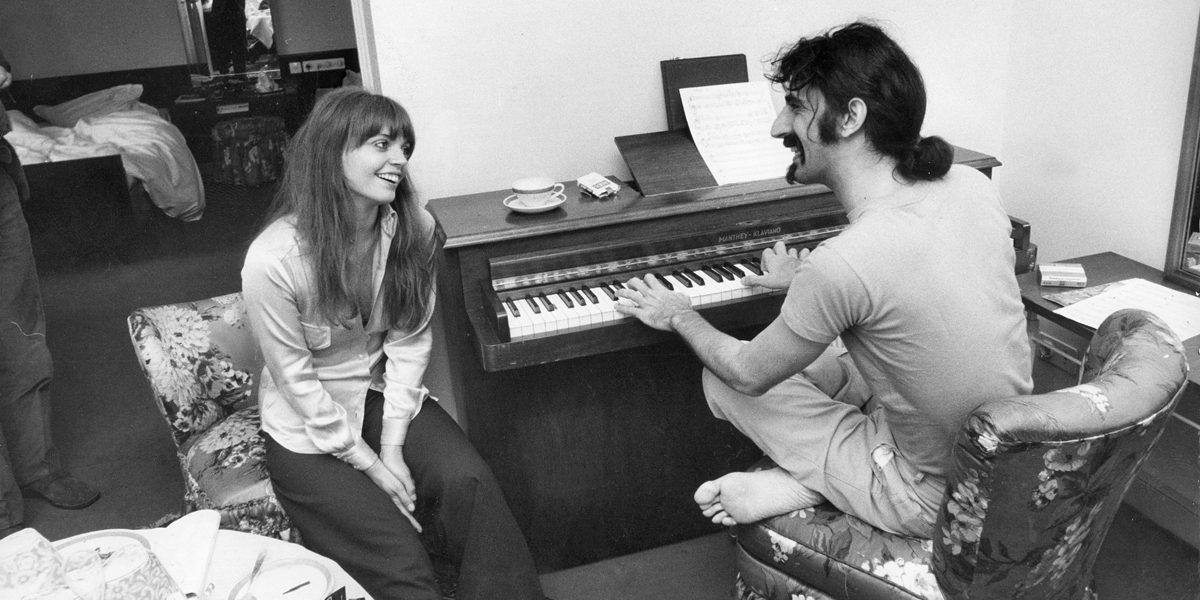 In December 2019 the ZFT released a multi-CD box, called "The Hot rats sessions".
It's an audio documentary CD, for the major part giving you the opportunity to be present
during the recordings of the basic tracks. As Matt Groening is explaining in the liner notes, it's still only a small
part of the total amount of recorded material because of the huge quantity of composed and improvised overdubbed parts.
Historically it shows what material got recorded on which date, as well as that several pieces had different working titles
at the beginning. These titles can be found on the reels and/or they get mentioned at the start of takes.
Musically some unused soloing sections are of interest as well as a few oddities as a "Little umbrellas" recording
from the Cucamonga period. To the right: Frank and Gail, around 1969.
In December 2019 the ZFT released a multi-CD box, called "The Hot rats sessions".
It's an audio documentary CD, for the major part giving you the opportunity to be present
during the recordings of the basic tracks. As Matt Groening is explaining in the liner notes, it's still only a small
part of the total amount of recorded material because of the huge quantity of composed and improvised overdubbed parts.
Historically it shows what material got recorded on which date, as well as that several pieces had different working titles
at the beginning. These titles can be found on the reels and/or they get mentioned at the start of takes.
Musically some unused soloing sections are of interest as well as a few oddities as a "Little umbrellas" recording
from the Cucamonga period. To the right: Frank and Gail, around 1969.
The Hot rats sessions included:
Original title Album of release Final title
Piano music (section 1) Burnt weeny sandwich Little house (piano introduction)
Piano music (section 3) Hot rats/Burnt weeny sandwich Peaches en regalia/Aybe sea
Peaches en regalia Hot rats idem
Peaches jam (unused)
Arabesque Weasels ripped my flesh Toad of the short forest
Dame Margret's son to be a bride Studio tan Lemme take you to the beach
It must be a camel Hot rats idem
Natasha Hot rats Little umbrellas
Bognor Regis (unused)
Willie the pimp Hot rats idem
Transition Chunga's revenge Twenty small cigars
Lil' Clanton shuffle The lost episodes idem
Directly from my heart to you Weasels ripped my flesh idem
Another waltz Burnt weeny sandwich Little house (solos)
Son of Mr. Green Genes Hot rats idem
Big legs Hot rats The Gumbo variations
In the LP era the length of an album and its format could sometimes be a problem. A contractual side was expected to last between 15 and
20 minutes, some minutes over 20 being possible. Since the latter diminished the sound quality, Zappa avoided that. Then
the next size step from a single album was a double album. An EP or a blank side as a way in between never got popular. You can see
that for strongly conceptual albums as "Joe's garage" and "Thing-Fish" choices had to be made. In the case of
"Joe's garage" the story ends with "Watermelon in eastern hay", leaving still half of a side remaining. It was solved by
including the "Little green rosetta" jam. For "Thing-Fish" the quantity of the play got between a double and a triple album. It could
fit on a double album, but then you would for instance be forced to cut "The torchum never stops" into two. In this case Zappa made
no concessions and chose for six short sides, shorter than normal. With the entrance of the CD this problem belonged to the past.
In the case of "Hot rats" the recording sessions resulted in a lot more than what's on the original album. In this case
we got to hear much of the overflow unaltered later on. Normally Zappa would record the unreleased material anew, so that it
would fit better on later albums. As I understand it Dweezil included an unused solo section from "Peaches en regalia" on one of his albums.
Zappa continued to record with the musicians from "Hot rats" in March 1970. Among these recordings are:
- The lost episodes: Sharleena.
- Quaudiophiliac: Chunga's basement.
Bognor Regis
Bognor Regis, 0:26-0:44 (midi file).
Bognor Regis, 0:26-0:44 (transcription).
It's built rather freely around a I-IV alternation in E Dorian. During the composed part, 0:00-0:38, this alternation takes place within a bar. When
the soloing starts at 0:39 it turns into an accompanying figure of two bars, with the bass pedal/chords alternating every bar.
Bars 5-6 from the example are the beginning of the solo section.
According to the liner notes, "Bognor Regis" over the years developed towards "Conehead",
a title included in the Läther section if this study. Not the 1977 "Conehead instrumental" from "Baby snakes", but the 1978
version that can be found on the "Saarbrücken" bootleg from the "Beat the boots" series, as well as the later "You are what you is" album. Indeed "Conehead"
is also using a I-IV alternation in Dorian, otherwise "Bognor Regis" and "Conehead" don't have much in common.
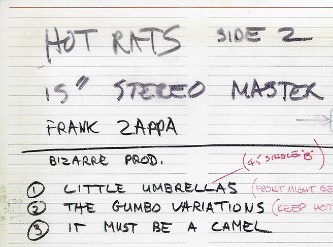

Outtakes of photos of the mastertape of "Hot rats" side 2, the left one in Zappa's handwriting. Source: The Hot rats sessions CD.
Peaches jam
FZ: Guitar
Violin: Don Harris
Johnny Otis: Tack piano
Ian Underwood: Piano
Shuggie Otis: Bass
Ron Selico: Drums
Peaches jam - part 2, 6:21-6:38 (midi file).
Peaches jam - part 2, 6:21-6:38 (transcription).
The second part is blues with the example from above containing half a blues-cycle with Zappa entering the picture. It's standard 12-bars blues in A Dorian with
an amount of liberty. Ian Underwood follows A Mixolydian, rather than Dorian. One might say Zappa himself is using A minor pentatonic
for his soloing. The meter is 12/8, strictly followed all through this 10-minute jam section.
Another waltz
FZ: Guitar
Don "Sugarcane" Harris: violin
Don Preston: piano, organ
Roy Estrada: bass
Jimmy Carl Black: drums
Another waltz, 4:38-5:02 (midi file).
Another waltz, 4:38-5:02 (transcription).
Various sections with Don Harris and Don Preston soloing landed on "Burnt weeny sandwich".
Zappa is playing two solos during this jam, of which nothing was used for an album. He starts "Another waltz" with counting rapidly as "one-two-three, one-two-three",
which explains the title waltz. The example from above is from the first guitar solo, where I've grouped four of such waltz bars into one 12/16 bar. The band is then playing
over a two-bar vamp. The general key of the session is D Dorian. The vamp knows a descending bass line D-C-B-A#/A. In a situation like this one might choose the lowest note as key note,
but this note isn't constant during this solo. A# is a chromatic note, the A natural suggests A minor.
Another waltz, 22:47-23:10 (midi file).
Another waltz, 22:47-23:10 (transcription).
The example from above is a section from the second guitar solo. Also in this case it's not that obvious what note should be seen as the tonic.
The bass player, Roy Estrada, is using a vamping figure, F-C-D. The F, as opening note, might suggest F Lydian, but the D is played lower and
is maintained longer as well. So I'd rather call this D Dorian. Identifying this block as D minor pentatonic is also very well possible.
The E only gets touched upon occasionally and the B is avoided altogether.
Lil' Clanton shuffle
Lil' Clanton shuffle, 0:38-0:50 (midi file).
Lil' Clanton shuffle, 0:38-0:50 (transcription).
In the "Lost episodes" booklet Zappa comments: "This is named after a gang in East L.A. We used to see "Lil' Clanton" sprayed on the walls
there in the '50s and '60s. It's a blues jam left off of Hot Rats in '69, featuring Suger Cane Harris. To me, he was a legend. I had
records he made in high school. "Soul motion", a favorite of mine, had a mean-ass blues violin solo. While making the Hot Rats LP,
I thought, "Wouldn't it be great if I could find that guy and put him on the album?". Since Johnny Otis was a DJ from that period in music,
I called him. He found Harris in jail - he was in on a drug bust - and we bailed him out. Johnny Otis said he was a very important musician needed
for recording work. The last I heard of Suger Cane Harris, he had a group called Tupelo Chain Sex."
Twenty small cigars
Twenty small cigars, opening (midi file).
Twenty small cigars, opening (transcription).
It opens with a piano introduction. Just as the "It must be a camel" example
from above it contains enlarged chords (bars 1, 3, 5-7), alternating with normal 5th chords (bars 2 and 4). It's in
E Dorian most of the time. The chord in bar 1, staff 1, is V 11th if you take the B as root. Again
rhythmic complexities enter the picture, as the syncopic triplets movement in bars 5 and 6, gliding over a 3/4 basis. In
bar 9 the main melody starts with one of the few instances of Zappa playing keyboard and guitar. It's a peaceful entirely
instrumental song.
